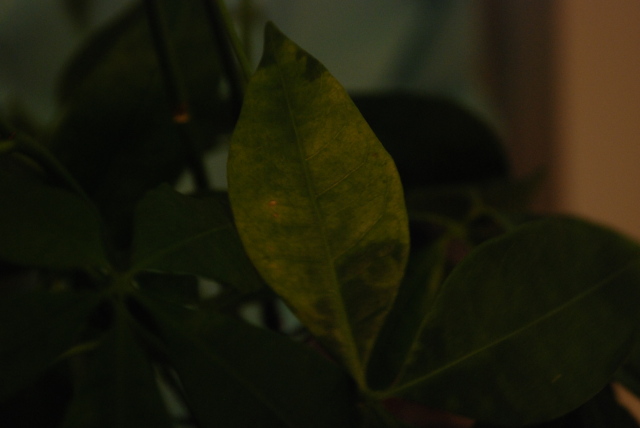Question
 leaf problems
leaf problems
My Pachira has been fine for several months now and all of a sudden its leaves are turning yellow-white. At the rate it happening it wont have any leaves in a couple of months. Its not in bright light and I'm extra careful not to over water. I haven't moved it or changed anything. I checked it for bugs but haven't found anything. I also have another one which I have had for a couple of years and its perfectly fine.
AnswerHi Jen,
Usually the most common cause of yellowing leaves on a Money Plant (Pachira) is improper watering. Keeping the soil a bit too moist or a bit too dry could cause a gradual decline of the roots that would then cause leaf yellowing.
As a general rule, allow the top 1-2 inches of soil to dry between watering then water just enough for a small amount of water to drain out of the drainage holes in the bottom of the pot.
Other causes of leaf yellowing are sudden changes in light, temperature and hot or cold drafts.
However, looking at the picture you attached to your question I can tell you that the cause is probably spider mites.
Even though you said that you checked the plant for insects, spider mites are tiny, spider like mites that can barely been seen with the naked eye. The most common spider mite is the Two-spotted Spider Mite, they have soft, light green, pear shaped bodies with 2 dark spots on their backs.
One of the most visible signs of a spider mite presence is webbing on the undersides of leaves and between stems, however, webbing indicates a high population of spider mites. Although spider mites are very hard to see with the naked eye, their eggs can usually be seen easily, grouped together on the undersides of leaves.
Looking at the underside of a leaf at a slight angle is helpful in making the eggs (and adult spider mites) easier to see.
The other most visible sign a plant has spider mites is the damage pattern on the leaves. That is what told me that your plant probably has spider mites.
Spider Mites are very difficult to get rid of or control. Often they are resistant to chemical pesticides and many insecticides do not work for Spider Mites. If you are going to use a commercial chemical pesticide be sure that it is listed on the label that the product is effective for spider mites.
The first step in getting rid of spider mites is to spray the leaves, especially the undersides, with a strong spray of water. This will wash off as many of the mites as possible. Since spider mites are often resistant to most chemical pesticides it is best to use an insecticidal soap spray.
There are several brands of Insecticidal soap sprays on the market to choose from or you can make a homemade insecticidal soap spray yourself. I always make my own insecticidal soap spray. Especially for spider mites because it seems that sometimes even commercial insecticidal soap sprays do not always really get rid of the mites.
The mixture that I have found that works best is fill a spray bottle 50% with alcohol and 50% with distilled water. Then add several drops of dishwashing liquid (I always use Dawn dishwashing liquid). Shake the spray bottle well. Be sure to thoroughly spray all leaf surfaces, especially the undersides.
The main drawback to insecticidal soap sprays is there is no lasting effect and you may have to repeat treatment every 5-7 days until there is no sign of spider mite presence.
I hope this helps. If you have any questions or need additional information please don't hesitate to ask.
Thanks
Tracy






